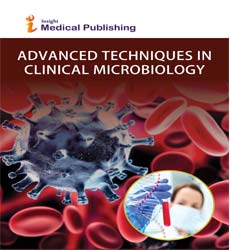Pharmaceutical Microbiology's Most Recent Trends
Abdelghani Mahmoudi*
Faculty of Applied Medical Sciences, Lovely Professional University, Phagwara, Punjab, India
- Corresponding Author:
- Abdelghani Mahmoudi
Faculty of Applied Medical Sciences
Lovely Professional University
Phagwara, Punjab, India
E-mail: mahmoudiabd@gmail.com
Received Date: December 04, 2021; Accepted Date: December 19, 2021; Published Date: December 26, 2021
Citation: Mahmoudi A (2021) Pharmaceutical Microbiology's Most Recent Trends. Adv Tech Clin Microbiol. Vol.3 No.3:113
Copyright: © 2021 Mahmoudi A. This is an open-access article distributed under the terms of the Creative Commons Attribution License, which permits unrestricted use, distribution, and reproduction in any medium, provided the original author and source are credited.
Introduction
As we moved into the twenty-first century, there were numerous changes in pharmaceutical microbiology. Some of these changes have occurred as a result of advances in quick microbiological technologies and knowledge obtained from the study of the human microbiome, while others have occurred as a result of changes in traditional testing methodologies. This paper discusses some of the recent shifts in microbiologists' areas of interest.
The Human Microbiome Project is a study of the microbiome of humans (HMP)
The information gathered through this initiative has revealed a lot about the link between humans and microorganisms. The information describes the enormous number of germs that have colonised humans. Some of these species could be "opportunistic pathogens" capable of infecting humans. In general, these creatures' interactions might be commensal, symbiotic, or harmful. The commensal connection benefits one of the organisms, either the person or the bacterium. Both the human and bacterial species benefit from symbiotic partnerships. When a microbe is recognised to cause a human infection, it is called a pathogenic connection. Much of the microbiological testing we do for the pharmaceutical business will benefit from a better understanding of these linkages [1].
The research of whether artificial intelligence can be used to examine gut bacteria in patients is another milestone in this sector. The Human Microbiome Effort and artificial intelligence are both involved in this project. This would allow bacteria to have artificial intelligence to evaluate themselves and their impact on various ailments, such as predicting surgery success, curing obesity, and so on [2].
In medicines, microorganisms become the active ingredient.
There have been a slew of new topical probiotic personal care products released. "The studies examined imply that topical prebiotics, probiotics, and bacterial cell lysates give evident skin advantages," according to Farris. As a result, topical treatments containing live microorganisms have emerged. The active ingredient in certain products may be more than 50,000 colony forming units of a microbe. The issue is how to pass some of the United States Pharmacopeia's examinations (USP). For example, USP 61> is for microbial enumeration testing, USP 62> is for microorganism testing, and USP 51> is for antimicrobial preservative effectiveness testing. Identifying techniques to preserve the formulation while utilising a preservative with a narrow spectrum to maintain the viability and efficacy of the active ingredient is one of the issues this causes [3].
Some bacteriophages are even employed in topical treatments. A virus that infects and replicates within a bacteria is the active ingredient.Faecal transplantation is a relatively young application of microbiology. The transfer of faeces from a healthy donor into the gastrointestinal system to treat recurrent C. difficile colitis or other disorders is known as faecal transplantation (or bacteriotherapy .Many of these illnesses can arise as a result of antibiotic treatment. Companies are striving to identify and transform these "good microbes" into pharmaceutical active components and products. This can present numerous difficulties for the microbiologist. Among the difficulties are the following:Healthy individuals are initially needed to provide the faecal material for transplantIsolation of the microorganisms that "make a difference" in treating a specific disease Finding a methodology to culture these organisms while maintaining their health benefits and creating a situation where they can be routinely cultured. Determining a methodology to evaluate the efficacy without giving it to patients [4].
References
- Lipuma J (2005) Update on the Burkholderia cepacia complex. Curr Opin Pulm Med 11: 528-33.
- Avgeri SG, Matthaiou DK, Dimopoulos G, Grammatikos AP, Falagas ME (2009) Therapeutic options for Burkholderia cepacia infections beyond co-trimoxazole: a systematic review of the clinical evidence. International Journal of Antimicrobial Agents 33: 394-404.
- Satyajit D (2015) Pharmaceutical Microbiology: An Applied Branch of Microbiology. Journal of Pharmaceutical Microbiology 1: 1.
- Kar A (2008) Pharmaceutical Microbiology. New Delhi: New Age International (P) Ltd.
Open Access Journals
- Aquaculture & Veterinary Science
- Chemistry & Chemical Sciences
- Clinical Sciences
- Engineering
- General Science
- Genetics & Molecular Biology
- Health Care & Nursing
- Immunology & Microbiology
- Materials Science
- Mathematics & Physics
- Medical Sciences
- Neurology & Psychiatry
- Oncology & Cancer Science
- Pharmaceutical Sciences
